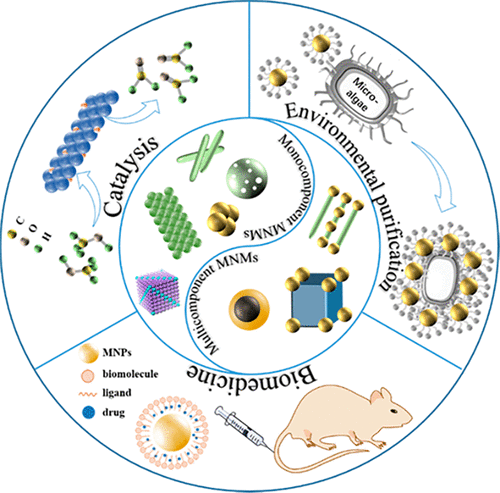当前位置:
X-MOL 学术
›
Acc. Chem. Res.
›
论文详情
Our official English website, www.x-mol.net, welcomes your
feedback! (Note: you will need to create a separate account there.)
Magnetic Nanomaterials: Chemical Design, Synthesis, and Potential Applications
Accounts of Chemical Research ( IF 16.4 ) Pub Date : 2018-02-07 00:00:00 , DOI: 10.1021/acs.accounts.7b00407 Kai Zhu 1, 2 , Yanmin Ju 1, 3 , Junjie Xu 1 , Ziyu Yang 1 , Song Gao 4 , Yanglong Hou 1, 2
Accounts of Chemical Research ( IF 16.4 ) Pub Date : 2018-02-07 00:00:00 , DOI: 10.1021/acs.accounts.7b00407 Kai Zhu 1, 2 , Yanmin Ju 1, 3 , Junjie Xu 1 , Ziyu Yang 1 , Song Gao 4 , Yanglong Hou 1, 2
Affiliation

|
Magnetic nanomaterials (MNMs) have attracted significant interest in the past few decades because of their unique properties such as superparamagnetism, which results from the influence of thermal energy on a ferromagnetic nanoparticle. In the superparamagnetic size regime, the moments of nanoparticles fluctuate as a result of thermal energy. To understand the fundamental behavior of superparamagnetism and develop relevant potential applications, various preparation routes have been explored to produce MNMs with desired properties and structures. However, some challenges remain for the preparation of well-defined magnetic nanostructures, including exchange-coupled nanomagnets, which are considered as the next generation of advanced magnets. In such a case, effective synthetic methods are required to achieve control over the chemical composition, size, and structure of MNMs. For instance, liquid-phase chemical syntheses, a set of emerging approaches to prepare various magnetic nanostructures, facilitate precise control over the nucleation and specific growth processes of nanomaterials with diverse structures. Among them, the high-temperature organic-phase method is an indispensable one in which the microstructures and physical/chemical properties of MNMs can be tuned by controlling the reaction conditions such as precursor, surfactant, or solvent amounts, reaction temperature or time, reaction atmosphere, etc.
中文翻译:

磁性纳米材料:化学设计,合成和潜在应用
在过去的几十年中,磁性纳米材料(MNM)由于其独特的特性(如超顺磁性)而引起了人们的极大兴趣,超顺磁性是由热能对铁磁纳米颗粒的影响所致。在超顺磁尺寸范围内,纳米粒子的力矩由于热能而波动。为了了解超顺磁性的基本行为并开发相关的潜在应用,已探索了各种制备途径来生产具有所需特性和结构的MNM。然而,对于定义明确的磁性纳米结构的制备仍然存在一些挑战,包括被认为是下一代高级磁体的交换耦合纳米磁体。在这种情况下,需要有效的合成方法来实现对化学成分的控制,MNM的大小和结构。例如,液相化学合成是制备各种磁性纳米结构的一组新兴方法,有助于对具有多种结构的纳米材料的成核作用和特定的生长过程进行精确控制。其中,高温有机相法是必不可少的方法,其中可以通过控制反应条件(例如前体,表面活性剂或溶剂的量,反应温度或时间,反应)来调节MNM的微观结构和理化性质。气氛等
更新日期:2018-02-07
中文翻译:

磁性纳米材料:化学设计,合成和潜在应用
在过去的几十年中,磁性纳米材料(MNM)由于其独特的特性(如超顺磁性)而引起了人们的极大兴趣,超顺磁性是由热能对铁磁纳米颗粒的影响所致。在超顺磁尺寸范围内,纳米粒子的力矩由于热能而波动。为了了解超顺磁性的基本行为并开发相关的潜在应用,已探索了各种制备途径来生产具有所需特性和结构的MNM。然而,对于定义明确的磁性纳米结构的制备仍然存在一些挑战,包括被认为是下一代高级磁体的交换耦合纳米磁体。在这种情况下,需要有效的合成方法来实现对化学成分的控制,MNM的大小和结构。例如,液相化学合成是制备各种磁性纳米结构的一组新兴方法,有助于对具有多种结构的纳米材料的成核作用和特定的生长过程进行精确控制。其中,高温有机相法是必不可少的方法,其中可以通过控制反应条件(例如前体,表面活性剂或溶剂的量,反应温度或时间,反应)来调节MNM的微观结构和理化性质。气氛等











































 京公网安备 11010802027423号
京公网安备 11010802027423号